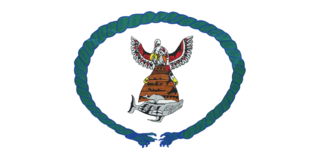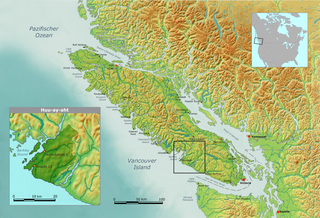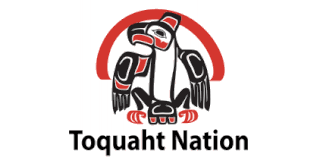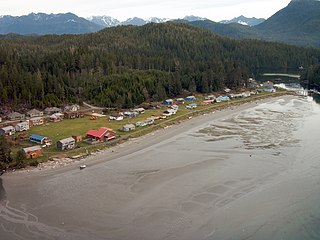
Clayoquot Sound is located on the west coast of Vancouver Island in the Canadian province of British Columbia. It is bordered by the Esowista Peninsula to the south, and the Hesquiaht Peninsula to the North. It is a body of water with many inlets and islands. Major inlets include Sydney Inlet, Shelter Inlet, Herbert Inlet, Bedwell Inlet, Lemmens Inlet, and Tofino Inlet. Major islands include Flores Island, Vargas Island, and Meares Island. The name is also used for the larger region of land around the waterbody.

The Nuu-chah-nulth, also formerly referred to as the Nootka, Nutka, Aht, Nuuchahnulth or Tahkaht, are one of the indigenous peoples of the Pacific Northwest Coast in Canada. The term Nuu-chah-nulth is used to describe fifteen related tribes whose traditional home is on the west coast of Vancouver Island.

The Tla-o-qui-aht First Nations are a Nuu-chah-nulth First Nation in Canada. They live on ten reserves along the Pacific Rim National Park Reserve on Vancouver Island, British Columbia. The band is part of the Nuu-chah-nulth Tribal Council. There were 618 people living in the Tla-o-qui-aht reserves in 1995. Their primary economic activities are fishing and tourism.

Wakashan is a family of languages spoken in British Columbia around and on Vancouver Island, and in the northwestern corner of the Olympic Peninsula of Washington state, on the south side of the Strait of Juan de Fuca.

The Hesquiaht First Nation is a Nuu-chah-nulth First Nations band government based on the west coast of Vancouver Island in British Columbia, Canada. The Hesquiaht First Nation are members of the Nuu-chah-nulth Tribal Council. Its members are Hesquiaht people.
Nuu-chah-nulth, a.k.a.Nootka, is a Wakashan language in the Pacific Northwest of North America on the west coast of Vancouver Island, from Barkley Sound to Quatsino Sound in British Columbia by the Nuu-chah-nulth peoples. Nuu-chah-nulth is a Southern Wakashan language related to Nitinaht and Makah.
The Mowachaht/Muchalaht First Nations are a First Nations government on the west coast of Vancouver Island in the Canadian province of British Columbia. The Mowachaht/Muchalaht First Nations are a member nation of the Nuu-chah-nulth Tribal Council, which spans all Nuu-chah-nulth-aht peoples except for the Pacheedaht First Nation.

Tseshaht First Nation is an amalgamation of many tribes up and down Alberni Inlet and in the Alberni Valley of central Vancouver Island in the Canadian province of British Columbia. They are a member of the Nuu-chah-nulth Tribal Council which includes all other Nuu-chah-nulth-aht peoples except the Pacheedaht First Nation.

The Yuułuʔiłʔatḥ Government or Ucluelet First Nation is the modern treaty government of the Yuułuʔiłʔatḥ in the Canadian province of British Columbia.
The Nuu-chah-nulth Tribal Council is a First Nations Tribal Council in the Canadian province of British Columbia, located on the west coast of Vancouver Island. The organization is based in Port Alberni, British Columbia.

The Ahousaht First Nation is a First Nation government based on the west coast of Vancouver Island in British Columbia, Canada. It administers the community of Ahousaht, British Columbia, which encompasses much of Clayoquot Sound. The Ahousaht are a member of the Nuu-chah-nulth Tribal Council. It is led by Chief A-in-chut Shawn Atleo and the Taayi Haw̓ił - Maquinna.

The Huu-ay-aht First Nations is a First Nations band government based on Pachena Bay about 300 km (190 mi) northwest of Victoria, British Columbia on the west coast of Vancouver Island, in Canada. The traditional territories of the Huu-ay-aht make up the watershed of the Sarita River. The Huu-ay-aht is a member of the Nuu-chah-nulth Tribal Council and is a member of the Maa-nulth Treaty Society. It completed and ratified its community constitution and ratified the Maa-nulth Treaty on 28 July 2007. The Legislative Assembly of British Columbia passed the Maa-nulth First Nations Final Agreement Act on Wednesday, 21 November 2007 and celebrated with the member-nations of the Maa-nulth Treaty Society that evening.

The Toquaht Nation is a modern treaty government located on the west coast of Vancouver Island in British Columbia, Canada. It is a member of the Maa-nulth Treaty Society and the Nuu-chah-nulth Tribal Council.

The Pacheedaht First Nation is a First Nations band government based on the west coast of Vancouver Island in British Columbia, Canada. Although the Pacheedaht people are Nuu-chah-nulth-aht by culture and language, they are not a member of the Nuu-chah-nulth Tribal Council and define themselves differently.

Opitsaht, spelled also as Opitsat and Opitsitah, is a Tla-o-qui-aht settlement/community in the Southwest area of the Meares Islands, Clayoquot South, British Columbia. This peninsula-like region is the home to the Tla-o-qui-aht people from the Nuu-chah-nulth nation, a tribe from the Pacific Northwest region in the lower Vancouver area, known for their lifestyle revolving around the marine life trade and culture within the community.
Kiix-in, or Kiix?in , earlier romanized as Keeshan, was the principal residence of the Huu-ay-aht (Ohiaht) group of the Nuu-chah-nulth people. The name is onomatopoeic, and comes from the sound of waves crashing against the rocks below the village. It was initially romanised as "Keeshan", but was redesignated "Kiix-in " in line with the Maa-nulth Treaty.
The Nuu-chah-nulth Economic Development Corporation (NEDC) was incorporated in 1984 under the Canada Corporations Act as a not-for-profit organization. Although it is not tied directly to the NTC, it was formed to help the Nuu-chah-nulth people achieve economic and social independence by providing financial assistance and advisory services. NEDC manages a number of funding programs aimed at enhancing economic development in the region.
The Nuu-Chah-Nulth Employment and Training Program (NETP) is a program that seeks to help all aboriginal people with education and training. The overall mission of the NETP is to increase the quality of life, self-reliance and economic prosperity of aboriginal people and organizations within the Nuu-chah-nulth Tribal Council region by supporting and empowering career and employment aspirations.
The West Coast Vancouver Island Aquatic Management Board is one of Canada's only co-management bodies for aquatic ecosystems. During the 1980s and 1990s, the federal government and coastal communities came to agree that a gap had to be closed; aquatic management decisions should start to include regional voices and representation, mainly coastal communities, fishermen, and First Nations.
Esowista Indian Reserve No. 3, also known as Esowista 3, is an Indian reserve located on the Esowista Peninsula in the Clayoquot Sound region of the west coast of Vancouver Island, British Columbia, Canada. Located at the head of Wickaninnish Bay, just east of Schooner Cove, it is part of the group of reserves under the governance of the Tla-o-qui-aht First Nations of the Nuu-chah-nulth peoples. Its population in 2006 was 160.











